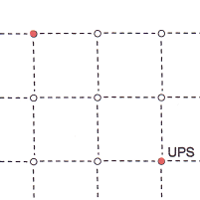By Michael Hartley
Here's a game that tunes kids' skills at planning and working out distances. What's more, the kids get to customize the worksheet for the game, which can only help them get more engaged with the exercise. Read on and I'll tell you how the game works, and give you the link for the printable game sheet!
The game is the brainchild of retired math teacher Mac Oglesby. He's used the game countless times in his own classes. I'm so glad he gave me permission to share it with you! Anyway, without further ado, let me explain how it works.
When you download the printable game sheet, you'll see a grid, with some orange dots. One of the dots is labeled "UPS". It's something like this:

You print off one worksheet for each student. Or, if the students are working in pairs, one worksheet for each pair. Print off some spares, just in case. The students will need pencils and a good eraser.
- Explain that what you've given them is a map of a city. Each of the unlabeled dots is the house of one of their friends. Ask them to write their friends' names next to each of the dots.
- The dot labeled UPS is the location of the UPS office. The UPS van must visit each house at least once, then return back to the office. The kids' job is to find the shortest route that lets the delivery dude do that. Make it a kind of competition to see who can find the shortest route! As the kids crack their heads against this puzzle, they'll get lots of practice counting distances, trying differnet ideas, and get a good intuition for efficient pathways.
- The next challenge is this: they have to choose a site for a grocery store: where should it be built to make the total distance from the store to each house as small as possible?
So, that's the UPS game! Mac Oglesby came up with it in the 1970s and produced his original version by programming it via an old teletype machine! The version you download here was made using more modern software.
You might find your pupils want more of this game, but of course you don't want to use the same map every time! Or, perhaps you want to customize the worksheet further, putting in your own town's name, or placing the dots in different places. Well, you can always make your own UPS game worksheets using graph paper!
- I've got a whole lot of square graph paper you can download and print, with squares of various sizes. This is a perfect use for it.
- You could even try the UPS game on triangular or hexagonal graph paper. Measuring distances on these will be more interesting than measuring them on a square grid!
- You could even go with the totally wild (and very beautiful) archimedean graph paper.
- A different way to make the puzzle more challenging is to erase some of the edges, or make some into one-way streets...
